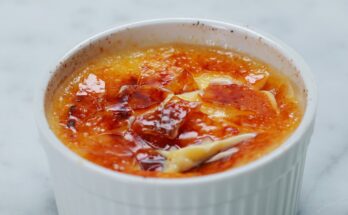Best Sangria Recipe: Sangria is more than just a drink—it’s a celebration in a glass. Imagine a refreshing blend of wine, chopped fresh fruit, a hint of spirits, and a touch of sweetness all coming together in one cool, colorful pitcher. Originating from Spain and Portugal, sangria is a popular party drink that’s taken the world by storm with its fruity, boozy charm. Whether you’re hosting a barbecue, planning a beach party, or just chilling on a sunny afternoon, sangria fits the bill perfectly.
But what makes sangria stand out is its versatility. You can tweak it to suit your preferences—use red wine, white wine, or even rosé. Add apples, oranges, or tropical fruits. Make it dry, sweet, boozy, or light. The combinations are endless, and that’s the beauty of this delicious drink.
History and Origins
Sangria has deep roots in Spanish culture, dating back to ancient times when wine was often mixed with water, fruits, and herbs to make it more palatable. This mix not only helped preserve the wine but also made it more refreshing during the hot summer months. Over the centuries, the drink evolved, eventually incorporating various regional fruits and spirits.
Its name comes from the Spanish word “sangre,” meaning blood—a nod to its traditional deep red color when made with red wine. Today, sangria is enjoyed worldwide and has become a staple on the menu of many restaurants and at countless parties.
Why You’ll Love This Sangria Recipe
Perfect for Any Occasion
One of the biggest reasons people love sangria is because it fits virtually any event. Hosting a brunch? A light white sangria with citrus fruits works beautifully. Throwing a backyard party? A robust red sangria with apples, oranges, and a splash of brandy sets the tone just right. Whether it’s a casual hangout or a festive gathering, this drink is always a crowd-pleaser.
And let’s be honest—sangria is incredibly easy to make in big batches. No fancy bartending skills required. You can prep it ahead of time, let it chill in the fridge, and have it ready to pour when guests arrive. It’s stress-free, fun, and oh-so-satisfying.
Customizable and Refreshing
The best part? You’re in total control of what goes in your sangria. Like it on the sweeter side? Add more fruit juice or a bit of sugar. Prefer something tart? Stick to citrus and use a dry wine. You can even make it non-alcoholic for the kiddos or anyone skipping the booze—just swap wine for grape juice or sparkling cider.
Customization isn’t just about flavor either. You can play around with textures by adding fizzy soda, switching up the fruit for a seasonal twist, or even serving it frozen on scorching days. It’s this flexibility that makes sangria an absolute favorite for drink lovers of all kinds.
Essential Ingredients for the Perfect Sangria
Choosing the Right Wine
Wine is the heart of sangria, so choosing the right one is crucial. Traditional sangria uses red wine—something fruity and medium-bodied like a Tempranillo, Garnacha (Grenache), or Merlot. These wines offer a great balance without overpowering the fruity elements.
But don’t let tradition box you in. White wines like Sauvignon Blanc or Pinot Grigio make for a crisp, light version. Rosé wines bring a floral note that pairs beautifully with summer berries. Whatever you choose, go for something drinkable on its own, but not too pricey—you’ll be mixing it, after all.
Also, avoid overly tannic or oaky wines, as they can clash with the fresh fruit flavors. Think of wine as the canvas—and you want a smooth one that lets the fruits and other ingredients shine.
Fresh Fruits That Work Best
Fruit is where sangria gets its soul. Oranges and apples are classic—especially for red wine sangria. They hold up well in liquid and infuse the drink with sweetness and a bit of tartness. Lemons and limes add a refreshing zing, while berries (strawberries, blueberries, raspberries) bring a pop of color and a burst of juicy flavor.
For white or tropical versions, go wild with pineapple, peaches, mango, or even kiwi. Don’t be afraid to mix textures—firmer fruits soak up the booze, while juicier ones release flavor into the mix.
Chop the fruit into bite-sized pieces, so they’re easy to eat and don’t clog up your glass. Also, avoid using fruits that oxidize quickly (like bananas) or turn mushy after a few hours.
Sweeteners and Spirits
Here’s where the magic kicks in. Traditional sangria recipes call for a bit of sugar, but you can use honey, agave syrup, or even fruit juice for sweetness. Orange juice is a favorite—it adds both sweetness and citrusy depth.
Adding a splash of liquor like brandy or triple sec gives sangria its characteristic kick. You could also try rum, vodka, or flavored liqueurs to match your chosen fruits. The idea is to enhance the wine, not overpower it, so use a light hand.
Now, let’s get into the how-to part next…
Tools You’ll Need
Basic Kitchen Tools
Before diving into the actual mixing, make sure you have the right tools at your disposal. The good news? You don’t need anything fancy. Most of these are common kitchen items:
- Large Pitcher – This is where the magic happens. A clear pitcher is ideal so you can show off the colorful mix of wine and fruits.
- Cutting Board and Knife – Essential for slicing up those fresh fruits.
- Wooden Spoon – For stirring and gently mashing the fruit to release more flavor.
- Measuring Cups and Spoons – Useful for adding just the right amount of liquor, juice, and sweetener.
- Wine Opener – Pretty obvious, but let’s not forget it!
- Refrigerator Space – Not a tool, technically, but you’ll need a good spot to chill your sangria for a few hours.
Having these tools ready ensures the process is smooth and mess-free. Plus, they make cleanup way easier.
Optional But Helpful Add-ons
- Citrus Juicer – Makes squeezing lemons, limes, or oranges way quicker and cleaner.
- Fruit Infuser Pitcher – Keeps fruit bits from clogging your glass while still infusing all that flavor.
- Sangria Glasses or Wine Glasses – Because presentation matters. Big glasses also give room for ice and fruit.
Step-by-Step Guide to Making Sangria
Let’s break down the actual process. Follow this simple step-by-step method, and you’ll be sipping on delicious homemade sangria in no time.
Step 1: Select Your Wine
As discussed earlier, go for a fruity, medium-bodied wine. Red is classic—Tempranillo, Merlot, or Garnacha are perfect. If it’s summer or you want something lighter, use a white like Sauvignon Blanc or even a rosé.
You’ll need 1 bottle (750 ml) of wine for this recipe.
Step 2: Prepare the Fruits
Choose 3–4 types of fruit for a balanced flavor. Here’s a great basic combo:
- 1 orange (sliced)
- 1 apple (cored and diced)
- 1 lemon (sliced thin)
- A handful of berries (optional)
Wash the fruit well, especially if you’re leaving the peel on (which adds flavor). Slice and dice them into small pieces so they can soak up the wine and release their juices easily.
Step 3: Add Liquor and Sweeteners
Pour your wine into the pitcher. Now add:
- 1/4 cup brandy (or triple sec, or a flavored liqueur)
- 1/4 cup orange juice
- 1–2 tablespoons sugar, honey, or agave syrup (to taste)
Give it a good stir to help dissolve the sweetener. Taste and adjust—add more juice for sweetness, more liquor for punch, or more fruit for flavor.
Step 4: Let It Chill and Marinate
This is the most important step. Cover the pitcher and place it in the fridge for at least 4 hours—overnight is even better. This lets all the flavors blend and the fruit to infuse into the wine.
Don’t skip this step! Sangria tastes 10x better once it’s had time to chill and mingle.
Step 5: Serve and Garnish
When it’s time to serve, give the sangria one last stir. Pour into glasses filled with ice and spoon in some fruit chunks. For extra flair, garnish with a sprig of mint, a citrus twist, or even a splash of club soda or sparkling water for fizz.
Boom—you’ve got yourself the ultimate sangria.
Tips to Elevate Your Sangria
Balance the Flavors
Creating a sangria that tastes like it came straight from a Spanish villa is all about balance. You want the wine, fruit, and spirits to complement—not overpower—each other. Too much sugar can make it cloying, while too much liquor can turn it harsh. Start light with your sweeteners and spirits, then adjust after your sangria has chilled and the flavors have had time to blend.
It’s also important to match your wine and fruits. A bold red might need heartier fruits like apples, oranges, or cherries, while a crisp white can pair beautifully with peaches, pears, or citrus. Use fruit juice for sweetness instead of sugar if you want a more natural taste. And don’t forget acidity—citrus like lemon or lime helps brighten the drink and keep it from tasting flat.
Avoiding Common Mistakes
Even though sangria is simple, a few common missteps can take your drink from wow to meh:
- Over-soaking the fruit: Some fruits break down and turn mushy after sitting too long. Avoid adding delicate fruits like bananas or melons until right before serving.
- Using poor-quality wine: While you don’t need a premium bottle, skip anything you wouldn’t drink on its own. Bad wine = bad sangria.
- Overdoing the liquor: Remember, sangria is meant to be sippable and refreshing. Keep the hard stuff to a minimum.
- Skipping the chill time: This is crucial. Warm sangria tastes disjointed. Always chill it for at least 4 hours to allow the flavors to come together.
- Using ice in the pitcher: Ice waters it down too fast. Chill the sangria in the fridge and add ice only when serving, directly into the glasses.
Taking the time to get these little things right really elevates your sangria from good to unforgettable.
Sangria Variations You Must Try
Sangria is like a playlist—you can remix it however you want, depending on your mood or the season.
White Sangria
Light, crisp, and perfect for warmer weather. Use white wine like Pinot Grigio, Sauvignon Blanc, or even a dry Riesling. Add fruits like green apple, pear, lemon, lime, and peaches. A splash of peach schnapps or elderflower liqueur takes this to the next level.
Serve white sangria ice-cold, and consider topping each glass with a little sparkling water or prosecco for an extra-refreshing touch.
Sparkling Sangria
Want something fizzy and festive? Go for a sparkling sangria. Start with a dry sparkling wine—cava, prosecco, or champagne all work well. Skip the extra soda since the wine already brings the bubbles. Pair with citrus fruits, berries, or even pomegranate seeds for visual flair.
Important: add the sparkling wine just before serving to preserve the bubbles. It’s a great choice for New Year’s Eve, brunch, or any celebration.
Tropical Sangria
Take your taste buds on vacation. Use white or rosé wine as your base, and mix in fruits like mango, pineapple, kiwi, and passionfruit. Coconut rum or mango vodka makes a delicious spirit addition.
This version screams beach party. Chill it with frozen fruit instead of ice for a drink that stays cold and doesn’t dilute.
Serving Suggestions
Best Time to Serve
Sangria fits just about any occasion. Summer BBQs, rooftop brunches, wedding receptions, holiday parties—you name it. Because you can prepare it ahead of time, it’s perfect for gatherings where you want to enjoy the event instead of playing bartender.
Make a big batch in a beautiful pitcher, and let guests serve themselves. For an even more Instagram-worthy setup, offer a DIY sangria bar with wine, pre-chopped fruits, and mixers so everyone can customize their drink.
Food Pairings
Sangria is versatile, so pair it with light, flavorful dishes. Some winning combinations include:
- Tapas: Think olives, almonds, cheese, and cured meats.
- Grilled meats: Especially with red sangria. Try BBQ ribs or steak skewers.
- Seafood: White or tropical sangria pairs amazingly with shrimp, ceviche, or fish tacos.
- Paella: The classic Spanish dish and sangria are a match made in heaven.
- Fruit and cheese platters: A refreshing snack that echoes the flavors of the drink.
Avoid pairing sangria with heavy, creamy dishes—they can clash with the fruity acidity.
Storage and Shelf Life
How Long Does Sangria Last?
Sangria tastes best when it’s fresh, but if you have leftovers, you can definitely store them. Just keep in mind that it’s not like wine—it doesn’t age well. Store any leftover sangria in an airtight container or keep it tightly covered in the original pitcher in the fridge. It will last up to 3–4 days, though it’s best consumed within the first 24–48 hours for the freshest flavor.
The fruit will continue to soak up the liquid and break down over time, so the texture changes. You might also notice the taste getting stronger or slightly bitter if citrus rinds are left too long. If this happens, just strain out the old fruit and add a few fresh slices before serving again.
Can You Freeze Sangria?
Technically, yes—you can freeze sangria, especially if you’re making popsicles or slushies out of it. Just pour the leftovers into ice cube trays or zip-top bags. Use the frozen cubes to chill future batches or blend them for a frozen sangria.
However, freezing sangria does alter the flavor and texture of the fruit, and the wine won’t taste quite the same after thawing. It’s better to freeze sangria without the fruit if you plan to save it.
If you want to prep sangria in advance for a party, consider mixing the wine, spirits, and sweeteners a day ahead and refrigerating. Add fresh fruit just a few hours before serving for best results.
FAQs about Sangria Recipe
Can I make sangria without alcohol?
Yes! Substitute the wine with grape juice or a mix of juice and sparkling water. Skip the liquor, and use plenty of fresh fruit. It’s a great mocktail option for kids or non-drinkers.
What’s the best wine for sangria?
For red sangria, go with a fruity, medium-bodied wine like Garnacha or Merlot. For white, try Sauvignon Blanc or Pinot Grigio. Avoid overly oaky or tannic wines.
Is sangria stronger than regular wine?
It can be. The added liquor boosts the alcohol content, though you can adjust it to your liking. A standard sangria has around 10–12% alcohol by volume, depending on the mix.
Can I use frozen fruit?
Absolutely. Frozen fruit helps chill the sangria without watering it down. It’s also a great way to enjoy sangria out of season.
What’s the difference between Spanish sangria and other versions?
Traditional Spanish sangria is made with red wine, citrus fruits, and brandy. American or modern versions often include white wine, tropical fruits, and a variety of liquors and sweeteners.
Conclusion
Sangria is more than just a drink—it’s a vibe. Whether you’re sipping it poolside, serving it at brunch, or bringing it to a backyard BBQ, it brings fun, flavor, and a splash of flair to any occasion. The best part? It’s insanely easy to make and endlessly customizable. Start with good wine, fresh fruit, and a splash of spirit, and let your creativity take it from there.
So grab a pitcher, slice some fruit, and let your inner mixologist shine. Salud!



